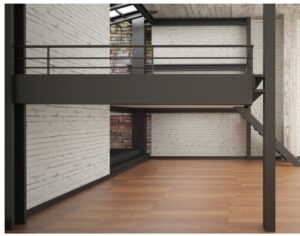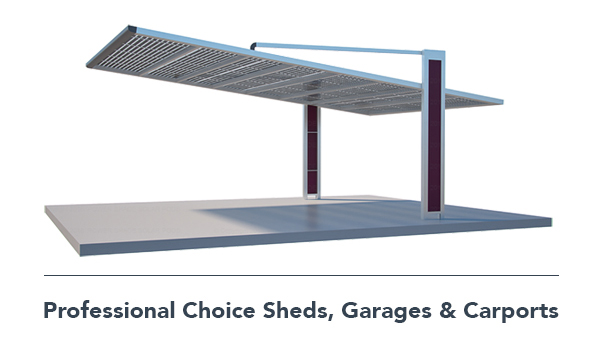If you are thinking of adding a Mezzanine Floor to your shed or warehouse, the first question is always what are DIY Mezzanine Floor Kit Prices? Price depends on the size of the mezzanine you need and the additions you add like safety rails and stairs. There is no doubt a mezzanine floor is a cost-effective investment fwhich increases the space in your warehouse or shed.
DIY Mezzanine Floor Kit Prices? Bigger the Mez, the less expensive per square metre.
A mezzanine floor will have a charge for bespoke engineering. The charge will be almost the same for a large mezzanine as it is for a small mezzanine. This means you pay ‘less’ per square metre for a large mezzanine floor than for a smaller one.
Below is a good guide for a mezzanine floor made from Australian High Tensile Steel. Shop around and you will find cheaper alternatives but it WILL NOT BE 450G + High tensile steel you are buying.
The following prices would include freight charges:-
(Prices – 450mm joist centres steel structure only) – Other options are available.
Large floor – Approx. 80+ square metres $150 per square metre
Medium floor – approx. 50 square metres $210 per square metre
Small floor – approx 15 square metres $265 per square metre.
DIY Mezzanine Floor Kit Prices? Australian Standards® 
There are Standards that must be followed for mezzanine floors. Some businesses will tell you that if you purchase a new shed with a mezzanine floor, the shed design will be upgraded to make sure the shed you purchase is strong enough to support an additional load that the floor might add. It’s good that they are admitting their sheds are barely strong enough to support their own weight, but ‘additional strength” should not be necessary if the shed was truly built to Australian Standards® in the first place.
A mezzanine floor can have no more than 2mm of vibration and this will be virtually impossible to achieve if Top Hats or mild steel is being used unless there is an awful lot in the floor to stop the vibration going above 2mm. Make sure you are using G450 to G500 High Tensile Steel.
The 7 Essential Elements of an Australian Standards® Compliant Mezzanine floor
Certified G450 to G500 High Tensile Steel
Require: – The Steel Grade & Manufacturer in writing. Engineers need Certified Span Capacities like those published by BlueScope® to verify steel suitability.
Avoid: – Ungraded, untested, or undocumented steel.
Put Safety First. Deflection Certified as Australian Standards® Compliant
Require: – The maximum Bearer & Joist Deflection in writing. Deflection, or sag under load, is critical & must be calculated for all Australian floors.
Avoid: – Undocumented Deflection. It is a simple calculation. Get it in writing.
Vibration Certified as Australian Standards® Compliant
Require: – The maximum Bearer & Joist Vibration in writing. Vibration, or bounce under load, is critical & must be calculated for all Australian floors.
Avoid: – Undocumented Vibration. It is a simple calculation. Get it in writing.
Raking Force exceeding 8.853kN or 885 kg
Require: – The exact amount of Raking Force required to keep the structure upright. Raking Force is a critical requirement for all Australian Flooring.
Avoid: – Undocumented Raking Force. It’s a simple calculation. Get it in writing.
C Section Bearers & Joists
Require: – C Sections due to their superior durability, strength & span capacities.
Avoid: – Top Hats & Top Span as they rarely satisfy Deflection & Vibration limits.
Product Mass
Require: – The mass in kilograms. Heavier steel generally means a sturdier floor.
Avoid: – Undocumented mass. Remember, less steel = more profit. Always double-check the weight on the Bill of Materials. People lie. Scales do not.
Check your documentation before purchase – How much for a DIY Mezzanine Floor Kit?
You will find that most mezzanine floors sold in Australia do not meet the requirements above. Even businesses like Lysaght will have Mezzanine floors supplied with bearers which are c250 or c300 and may describe them as “quite substantial” rather than “below Australian Standards®”.
Many people will be retrofitting a mezzanine floor. It is always better to do this as a free-standing mezzanine, using the mezzanine’s own posts to avoid affecting the engineering of the existing shed.
Always consider what parts of your warehouse or shed could get in the way if you want to install a new mezzanine floor. Wall columns, girts and roller doors can all get in the way resulting in a true floor space in a 6m x 6m shed closer to 4.5m x 5.5m. Watch also the clearance under and over the floor.
For DIY you need Simple, extensive building plans – How much for a DIY Mezzanine Floor Kit?
All plans should include in your construction documentation: –
- Bill of Materials so you can make sure everything is on-site before sending the crew. No wasted man-hours.
- Engineering Designs & Connection
- Full Certification
- Production drawings
You know your project will be safe with Professional Choice Sheds Custom Mezzanine floors. All engineering plans include easy-to-use QR Codes that take you directly to a help video to assist with any confusion with joints.
Professional Choice Sheds guarantee: – No mistakes, downtime or confusion – That’s why it’s the Professional’s Choice!

1 Comment